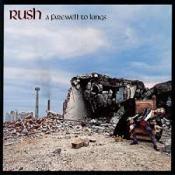20 Rush Albums in 20 Days: Clockwork Angels
 DAY NINETEEN: Clockwork Angels, running time 66:04, released June 12, 2012
DAY NINETEEN: Clockwork Angels, running time 66:04, released June 12, 2012
Listening to Clockwork Angels, one gets the feeling that Rush enjoyed writing and recording this album. Unlike Snakes and Arrows, there’s a sense of exploration and joy on this effort, with shifting moods, exciting riffs, some great hooks and plenty of moments that challenge each member of the band. It’s easily the band’s best effort since Test for Echo, and quite possibly their best album since the early 80s.
The opening “Caravan” immediately provides the hook and infectious chorus so often lacking in later Rush material, setting the stage with the universal chorus of “I can’t stop thinking big,” and “BU2B” provides an exciting opening riff and a memorable refrain.
The album gets bogged down a bit with the unnecessary effects and interludes. There’s hardly a guitar part that isn’t bathed in effects, filling up the entire stereo spectrum, and beginnings and endings of songs are extended with traces of vocal and guitar parts swept with ethereal effects, sometimes serving to give the listener a respite from the onslaught of sound, other times doing nothing but prolonging what should have been a much shorter effort. This isn’t Rush of 1981, after all; they are not at their prolific best. An album of 50 minutes would have been preferred.
A silly megaphone effect is employed on two successive songs: the title track, and again at 1:55 of “The Anarchist” before going back to a terrific chorus. As with many recent Rush songs, too often they write great parts of songs without writing an effective piece from beginning to end. “Carnies” is an example of a track whose verse is a complete mess, but whose other sections work extremely well.
“The Halo Effect” is a complete song – probably the album’s best – melodic from the start, accessible, with universal lyrics, and one of the few times in recent memory that a Rush song ends exactly when it should at just over three minutes. “The Wreckers” is another gem, perhaps going on a minute too long (particularly at the bridge at 2:50), but again a very good verse and chorus with a contagious guitar intro.
“Headlong Flight” is a blistering seven minutes of pure joy, employing brief allusions to Rush of yesteryear, including riffs from “Bastille Days” and “By-Tor and the Snow Dog.” It’s a powerhouse that I would expect to be included in any future tours the band might make, though I wonder if Clockwork Angels might be Rush’s swan-song. It wouldn’t be a bad way to cap off a forty-year career.
As with so many hard-rock albums these days, Rush squashed the sound too much in the mastering process. You can practically hear the limiter pumping at 1:10 of “Seven Cities of Gold” as Geddy reaches for the high notes. I also noticed it at 2:43 of “Carnies.” Not a preferred production technique, but it’s unfortunately been the trend of heavy rock music for the past decade. Listen to A Farewell to Kings back to back with Clockwork Angels and you’ll hear just how much production has changed since the 70s, and not all for the better.
“The Garden” ends the album with an touching summary of what one takes away after a long life of ups and downs. And then…it says it again and again, for almost seven minutes. But oh well. Such is the reality of an ambitious band in the CD age (though we’re almost out of that age, I would suspect).
Tomorrow, I’ll be listening to Caress of Steel, a very weird way to end a twenty-day journey.



